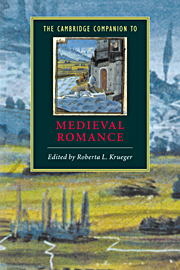Book contents
- Frontmatter
- Introduction
- Part 1 The origins, forms, and contexts of medieval romance
- Part 2 European romance and medieval society
- 5 Courts, clerks, and courtly love
- 6 The societal role of chivalry in romance
- 7 The other worlds of romance
- 8 Questions of gender in Old French courtly romance
- 9 Women and men in late medieval English romance
- Part 3 European transformations
- Editions and translations
- Index
- Series list
8 - Questions of gender in Old French courtly romance
from Part 2 - European romance and medieval society
Published online by Cambridge University Press: 28 May 2006
- Frontmatter
- Introduction
- Part 1 The origins, forms, and contexts of medieval romance
- Part 2 European romance and medieval society
- 5 Courts, clerks, and courtly love
- 6 The societal role of chivalry in romance
- 7 The other worlds of romance
- 8 Questions of gender in Old French courtly romance
- 9 Women and men in late medieval English romance
- Part 3 European transformations
- Editions and translations
- Index
- Series list
Summary
Critics and historians have long acknowledged that medieval French romances helped to promulgate ideals of chivalry and love throughout European courtly society and that those ideals held men and women to different standards of conduct. Notions of idealized “masculine” and “feminine” comportment were so forcefully articulated in medieval romances and didactic literature that their outlines survived well beyond the Victorian age: well-bred men should exercise courage and prudence in the public domains of government and war; ladies should devote themselves to the private sphere and cultivate the arts of adornment, sentimental refinement, and mothering. Scholars and critics today are quick to question such cultural constructions and to seek to discern the social realities that lie behind them, as do Richard Kaeuper and Sarah Kay in this volume, for example.
But critical reflection is not the exclusive purview of modern readers. Although many of the more than 200 extant French romances seem to uphold traditional gender roles without questioning them, others provide more complex, critical views of relations between men and women. Beginning with the earliest instances of romans d’antiquité, lais, and Arthurian romances, many courtly fictions opened up a discursive space where gender roles were scrutinized and where underlying social and sexual tensions were explored. After looking briefly at the historical context in which aristocratic gender roles evolved, this essay will take the intriguing thirteenth-century Roman de Silence as a guidepost for some of the question
- Type
- Chapter
- Information
- The Cambridge Companion to Medieval Romance , pp. 132 - 149Publisher: Cambridge University PressPrint publication year: 2000
- 1
- Cited by



